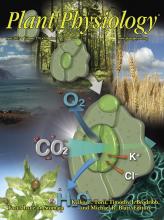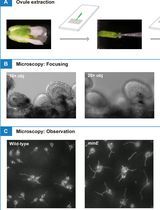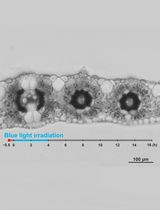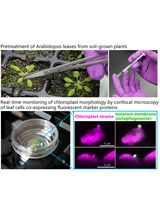- EN - English
- CN - 中文
Scanning Electron Microscopy of Motile Male Gametes of Land Plants
陆生植物游动雄配子的扫描电子显微镜观察
发布: 2017年10月05日第7卷第19期 DOI: 10.21769/BioProtoc.2570 浏览次数: 8163
评审: Scott A M McAdamAnonymous reviewer(s)
Abstract
The only motile cells produced in land plants are male gametes (spermatozoids), which are reduced to non-flagellated cells in flowering plants and most gymnosperms. Although a coiled architecture is universal, the complexity of land plant flagellated cells varies from biflagellated in bryophytes to thousands of flagella per gametes in the seed plants Ginkgo and cycads. This wide diversity in number of flagella is associated with vast differences in cell size and shape. Scanning electron microscopy (SEM) has played an important role in characterizing the external form, including cell shape and arrangement of flagella, across the varied motile gametes of land plants. Because of the size and scarcity of released swimming sperm, it is difficult to concentrate them and prepare them for observation in the SEM. Here we detail an SEM preparation technique that yields good preservation of sperms cells across plant groups.
Keywords: Flagella (鞭毛)Background
Motile gametes of land plants are strikingly diverse and develop through transformations that involve repositioning cellular components and the assembly of a complex locomotory apparatus (Renzaglia and Garbary, 2001). Because of constraints imposed by cell walls, elongation of the cell and flagella is around the periphery of a nearly spherical space, resulting in a coiled configuration of the mature gamete. The degree of coiling varies from just over one to as many as 10 revolutions per cell. The number of flagella per gamete is even more variable, ranging from two in bryophytes (mosses, hornworts, and liverworts) to an estimated 1,000-40,000 in Ginkgo and cycads. Following the diversification of Ginkgo and cycads, all vestiges of basal bodies and flagella were lost in the remaining seed plants that utilize pollen tubes to deliver non-motile sperm to egg cells (Southworth and Cresti, 1997). Male gametes provide a wealth of biological information, including biodiversity and cell differentiation and evolution (Garbary et al., 1993; Renzaglia et al., 1995; Renzaglia and Garbary, 2001; Renzaglia et al., 2000; Lopez-Smith and Renzaglia, 2008; Lopez and Renzaglia, 2014). Of the range of microscopic techniques utilized to characterize plant spermatozoids, SEM provides the most direct means of elucidating cell shape, and flagella number, length and arrangement. Together with TEM observations, SEM studies lead to comparative descriptions of gamete architecture, and organellar content and arrangement across plant lineages (Renzaglia et al., 2001 and 2002; Lopez-Smith and Renzaglia, 2008).
Materials and Reagents
Scanning Electron Microscopy (SEM) and the motile sperm cell architecture
- Pipette tips 1-200 µl (Carolina Biological Supply, catalog number: 215055 )
- Pasteur pipettes (Fisher Scientific, catalog number: 13-678-4)
Manufacturer: Corning, catalog number: C7095B5X .
- 1.5-ml centrifuge tubes (USA Scientific, catalog number: 1615-5500 )
- Glass coverslips 22 x 22 mm (Fisher Scientific, catalog number: 12-542B )
- Male plants with mature sperm cells
- Pellia epiphylla
- Conocephalum conicum
- Equisetum arvense
- Ceratopteris richardii
- Pellia epiphylla
- Sorensens phosphate buffer, 0.2 M, pH 7.2 (Electron Microscopy Sciences, catalog number: 11600-10 )
- Glutaraldehyde (Electron Microscopy Sciences, catalog number: 16120 )
- Sodium cacodylate buffer, 0.2 M, pH 7.4 (Electron Microscopy Sciences, catalog number: 11652 )
- Osmium tetroxide (Electron Microscopy Sciences, catalog number: 19150 )
- Ethanol (Decan Laboritories, catalog number: 2705HC )
- Hexamethyl disilizane (HMDS) (Electron Microscopy Sciences, catalog number: 16700 )
- 0.01 M phosphate buffer (pH 7.2) (see Recipes)
- 0.05 M phosphate buffer (pH 7.2) (see Recipes)
- 0.02 M phosphate buffer (pH 7.2) (see Recipes)
- 2.5% glutaraldehyde (see Recipes)
- 0.05 M sodium cacodylate buffer (pH 7.2) (see Recipes)
- 2% aqueous osmium tetroxide (see Recipes)
Equipment
- Scanning electron microscope (SEM) (FEI, model: QuantaTM 450 FEG )
- Shaker (Thermolyne, model: M-16715 )
- Centrifuge (Thermo Fisher Scientific, Thermo ScientificTM, model: mySPINTM 6 , catalog number: 75004061)
- Oven (General Signal, model: Gravity convection )
- SEM Specimen Mount Stubs, Aluminum Slotted Head (Electron Microscopy Sciences, catalog number: 75220 )
- Samdri 790 Critical Point Dryer (Tousumis)
- Sputter coater (Denton Vacuum, model: Desk V )
Procedure
文章信息
版权信息
© 2017 The Authors; exclusive licensee Bio-protocol LLC.
如何引用
Readers should cite both the Bio-protocol article and the original research article where this protocol was used:
- Renzaglia, K. S., Lopez, R. A. and Schmitt, S. J. (2017). Scanning Electron Microscopy of Motile Male Gametes of Land Plants. Bio-protocol 7(19): e2570. DOI: 10.21769/BioProtoc.2570.
- Renzaglia, K. S., Villarreal, J. C., Piatkowski, B. T., Lucas, J. R. and Merced, A. (2017). Hornwort Stomata: Architecture and Fate Shared with 400-Million-Year-Old Fossil Plants without Leaves. Plant Physiol 174(2): 788-797.
分类
细胞生物学 > 细胞成像 > 电子显微镜
植物科学 > 植物细胞生物学 > 细胞成像
您对这篇实验方法有问题吗?
在此处发布您的问题,我们将邀请本文作者来回答。同时,我们会将您的问题发布到Bio-protocol Exchange,以便寻求社区成员的帮助。
提问指南
+ 问题描述
写下详细的问题描述,包括所有有助于他人回答您问题的信息(例如实验过程、条件和相关图像等)。
Share
Bluesky
X
Copy link












